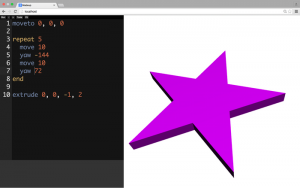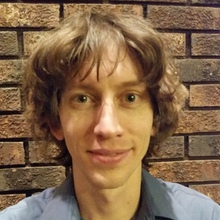In a world driven by user demand and competition in the marketplace, we have the luxury of user-friendliness and vibrant, colorful visual 3D displays nearly everywhere — and most certainly in all of our electronic devices like the smartphone or tablet.
As 3D printing becomes more affordable, accessible, and valid as a medium here to stay — not to mention continually progress — the world of 3D design is being explored and innovated in like never before. As that happens, it becomes even more user-friendly and more natural looking — so much so that it’s easy to forget there is a language driving it.
While many creative types would like to just hit the drawing board — in the digital sense — and create visually without thinking about what goes on behind the scenes, there is a whole world of computer science — and human programmers — making this possible.
With the magic of someone passionate about innovation as well as their own creation, Chris Johnson of Wisconsin, a teacher who teaches users how to ‘teach machines,’ invites his students to ‘walk paths through 3D space,’ using standard programming language.
That’s a pretty enticing invitation for learning — and with a new Kickstarter campaign, Johnson not only wants us all to be aware of the languages which drive our ability to create in the digital world, he wants students especially to learn how to become comfortable with programming, and he has created a programming language for them to learn called Madeup, which allows them to code for shapes — and in the ultimate reward, see a tangible result on 3D printing them.
As Johnson says, students are learning to make things up with the Madeup language — literally — with the technology of digital design and 3D printing as it prints up layer by layer — and there’s certainly no down side to that.
It’s a winning combination of learning and reward, with students focusing on shapes and their structure, as well as how important mathematics are in the natural world. It’s a perfect STEAM (science, technology, engineering, art, math) learning device as kids learn about not only computer programming but also numerous other disciplines. Johnson is able to grab their interest by showing them the opportunity to write their own programs for producing something like an item out of a video game or a cool figurine.
They can write programs to produce solid structures, hexagons, spheres, tubes, and other complex shapes and geometries. The comprehensive language teaches them about:
- Mathematical operations

A star extruded into a solid
- Conditional statements
- Loops
- Arrays
- Boolean logic
- Variables
- Functions
- Recursion
- Higher-order functions
- Partial function application
Hoping to raise a relatively modest $2,500 by April 30th, the program is in the alpha stages and still needs some smoothing out around the edges. His team has tested out the Madeup program at public libraries and schools with great success, measured by the enthusiasm of students who were able to master the information as well as asking questions about how to make other more complex shapes, and moving on to do so.
Supporters contributing $50 receive early access to the Madeup program, with documentation, for coding models. As pledges ascend from the $75 mark, supporters receive exciting 3D printed items along with access to Madeup. At $75, they also receive a “3D printed ceramic rupee, the Hyrulean currency” (from the Legend of Zelda gaming world). At $100, they also receive a 3D printed ceramic trivet, and at $250, a keychain. Supporters who top the charts, with their $500 pledge, receive a half-day workshop for a student group in 2016.
Bringing algorithms to life, literally, the Madeup team hopes to “clean up the interface” of the Madeup system and prepare it for educational programs, summer camps, resources for educators teaching K-12, as well as introductory programming classes and outreach programs. The Madeup product team is comprised of teachers who hope to use the Kickstarter funds in their off time this summer to clean up some of the remaining bugs, as well as add more documentation, lessons, an account system, and other improvements.
Is this a product you are planning to support on Kickstarter? Discuss with us in the Madeup forum thread over at 3DPB.com.
Subscribe to Our Email Newsletter
Stay up-to-date on all the latest news from the 3D printing industry and receive information and offers from third party vendors.
You May Also Like
3D Printing Financials: Fathom Struggles in Financial Quicksand During Critical Transition
Facing a year of key transitions and financial pressures, Fathom (Nasdaq: FTHM) has filed its annual report for 2023 with the U.S. Securities and Exchange Commission (SEC). The document outlines...
Latest Earnings Overview for Australian 3D Printing Firms Titomic and AML3D
Australian 3D printing manufacturing firms Titomic (ASX: TTT) and AML3D (ASX: AL3) reported their financial results for the period from July to December 2023, marking the first half of their...
3D Printing Webinar and Event Roundup: April 7, 2024
Webinars and events in the 3D printing industry are picking back up this week! Sea-Air-Space is coming to Maryland, and SAE International is sponsoring a 3D Systems webinar about 3D...
3D Printing Financials: Unpacking Farsoon and BLT’s 2023 Performance
In the Chinese 3D printing industry, two companies, Farsoon (SHA: 688433) and Bright Laser Technologies, or BLT (SHA: 688333), have recently unveiled their full-year earnings for 2023. Farsoon reported increases...



































